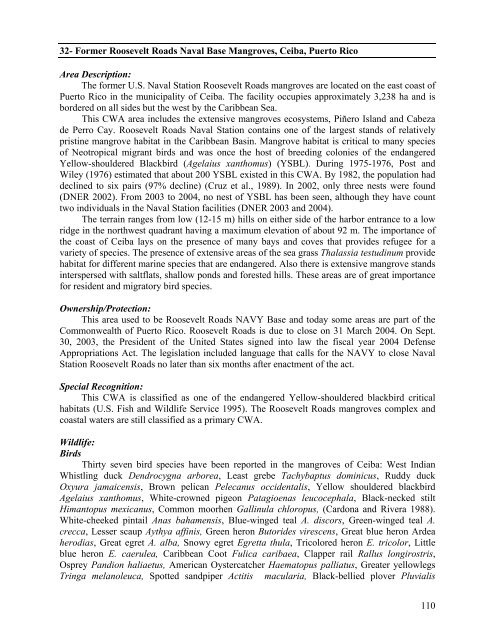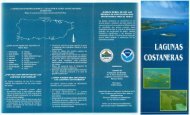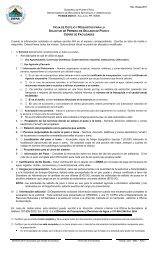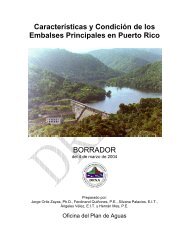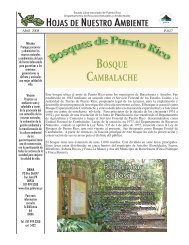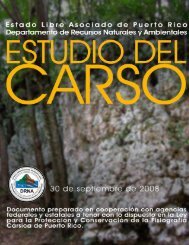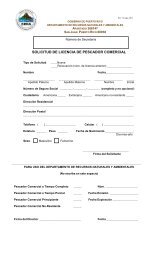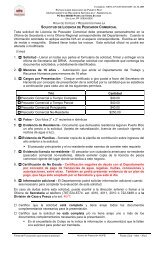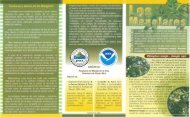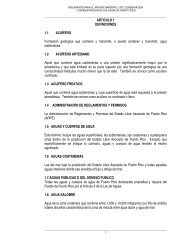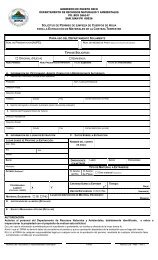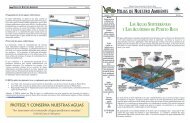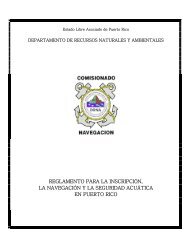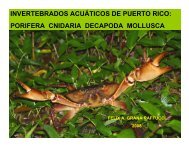Puerto Rico Critical Wildlife Areas - Puerto DRNA - Gobierno de ...
Puerto Rico Critical Wildlife Areas - Puerto DRNA - Gobierno de ...
Puerto Rico Critical Wildlife Areas - Puerto DRNA - Gobierno de ...
Create successful ePaper yourself
Turn your PDF publications into a flip-book with our unique Google optimized e-Paper software.
32- Former Roosevelt Roads Naval Base Mangroves, Ceiba, <strong>Puerto</strong> <strong>Rico</strong><br />
Area Description:<br />
The former U.S. Naval Station Roosevelt Roads mangroves are located on the east coast of<br />
<strong>Puerto</strong> <strong>Rico</strong> in the municipality of Ceiba. The facility occupies approximately 3,238 ha and is<br />
bor<strong>de</strong>red on all si<strong>de</strong>s but the west by the Caribbean Sea.<br />
This CWA area inclu<strong>de</strong>s the extensive mangroves ecosystems, Piñero Island and Cabeza<br />
<strong>de</strong> Perro Cay. Roosevelt Roads Naval Station contains one of the largest stands of relatively<br />
pristine mangrove habitat in the Caribbean Basin. Mangrove habitat is critical to many species<br />
of Neotropical migrant birds and was once the host of breeding colonies of the endangered<br />
Yellow-shoul<strong>de</strong>red Blackbird (Agelaius xanthomus) (YSBL). During 1975-1976, Post and<br />
Wiley (1976) estimated that about 200 YSBL existed in this CWA. By 1982, the population had<br />
<strong>de</strong>clined to six pairs (97% <strong>de</strong>cline) (Cruz et al., 1989). In 2002, only three nests were found<br />
(DNER 2002). From 2003 to 2004, no nest of YSBL has been seen, although they have count<br />
two individuals in the Naval Station facilities (DNER 2003 and 2004).<br />
The terrain ranges from low (12-15 m) hills on either si<strong>de</strong> of the harbor entrance to a low<br />
ridge in the northwest quadrant having a maximum elevation of about 92 m. The importance of<br />
the coast of Ceiba lays on the presence of many bays and coves that provi<strong>de</strong>s refugee for a<br />
variety of species. The presence of extensive areas of the sea grass Thalassia testudinum provi<strong>de</strong><br />
habitat for different marine species that are endangered. Also there is extensive mangrove stands<br />
interspersed with saltflats, shallow ponds and forested hills. These areas are of great importance<br />
for resi<strong>de</strong>nt and migratory bird species.<br />
Ownership/Protection:<br />
This area used to be Roosevelt Roads NAVY Base and today some areas are part of the<br />
Commonwealth of <strong>Puerto</strong> <strong>Rico</strong>. Roosevelt Roads is due to close on 31 March 2004. On Sept.<br />
30, 2003, the Presi<strong>de</strong>nt of the United States signed into law the fiscal year 2004 Defense<br />
Appropriations Act. The legislation inclu<strong>de</strong>d language that calls for the NAVY to close Naval<br />
Station Roosevelt Roads no later than six months after enactment of the act.<br />
Special Recognition:<br />
This CWA is classified as one of the endangered Yellow-shoul<strong>de</strong>red blackbird critical<br />
habitats (U.S. Fish and <strong>Wildlife</strong> Service 1995). The Roosevelt Roads mangroves complex and<br />
coastal waters are still classified as a primary CWA.<br />
<strong>Wildlife</strong>:<br />
Birds<br />
Thirty seven bird species have been reported in the mangroves of Ceiba: West Indian<br />
Whistling duck Dendrocygna arborea, Least grebe Tachybaptus dominicus, Ruddy duck<br />
Oxyura jamaicensis, Brown pelican Pelecanus occi<strong>de</strong>ntalis, Yellow shoul<strong>de</strong>red blackbird<br />
Agelaius xanthomus, White-crowned pigeon Patagioenas leucocephala, Black-necked stilt<br />
Himantopus mexicanus, Common moorhen Gallinula chloropus, (Cardona and Rivera 1988).<br />
White-cheeked pintail Anas bahamensis, Blue-winged teal A. discors, Green-winged teal A.<br />
crecca, Lesser scaup Aythya affinis, Green heron Butori<strong>de</strong>s virescens, Great blue heron Ar<strong>de</strong>a<br />
herodias, Great egret A. alba, Snowy egret Egretta thula, Tricolored heron E. tricolor, Little<br />
blue heron E. caerulea, Caribbean Coot Fulica caribaea, Clapper rail Rallus longirostris,<br />
Osprey Pandion haliaetus, American Oystercatcher Haematopus palliatus, Greater yellowlegs<br />
Tringa melanoleuca, Spotted sandpiper Actitis macularia, Black-bellied plover Pluvialis<br />
110


